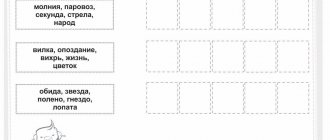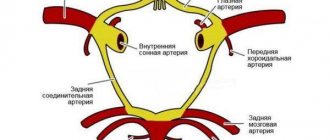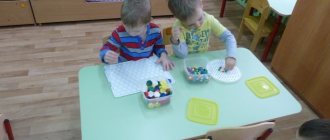Any parent wants only the best for their child, which is why they surround them with care and attention from childhood. And it is very important to pay special attention to the development of memory in preschool children. Fortunately, there are a huge number of different games and exercises that will help you achieve your goal in an easy, unobtrusive manner. The main secret of success is systematic training. Don't think that your memory will improve overnight. You need to set yourself and your child up for regular training.
Let's look at the main types of memory and their features.
- Visual memory is the ability to focus attention on certain events, phenomena and images, recording the information received in memory.
- Auditory memory is the ability to remember information through auditory images.
- Olfactory memory is a figurative memory directly related to the work of the olfactory analyzers.
- Tactile memory is a psychophysiological process of storing information through tactile analyzers.
- Taste memory - the work of taste analyzers is aimed at remembering tastes.
Based on the type and characteristics of the child’s mental activity, memory is divided into:
- Motor - focused on memorizing various movements and their systematicity. For children, this memory performs an important function in the formation of motor skills (walking, running, finger motor skills).
- Figurative - the ability to record information through the six main senses (vision, hearing, taste, smell, touch, vestibular analyzer). It is believed that it is figurative memory that dominates the development of preschool children.
- Emotional - memory for emotional sensations. Preschool children express their emotions especially vividly, especially relying on previously acquired experiences (feelings of joy, sadness, fear, and others).
- Verbal-logical is verbal memory. The child remembers definitions, statements, conclusions.
The information received by a preschool child can be divided into short-term memory, long-term memory, and operational memory.
RAM allows you to record certain knowledge until the moment when it is needed to carry out assigned tasks.
Short-term memory is characterized by the storage and reproduction of information immediately after it is received.
Long-term memory is characterized by the ability to accumulate information for an indefinite amount of time.
There is also a division into voluntary and involuntary memory. Their difference is that involuntary memorization is the absorption of information by immersion in the process without exerting effort, and voluntary memorization is the ability to diligently study information using certain character traits (perseverance, the ability to abstract, highlight the main thing).
Memory impairment
Memory impairment in children of primary school age can be a separate defect in the formation of mental functions or part of a whole complex of them. A child with a weak memory usually does not master the school curriculum well and violates discipline in the classroom. Impaired short-term memory leads to the fact that schoolchildren have difficulty remembering the content of the lesson and the teacher’s instructions. This can lead to serious performance problems. Due to memory problems, children are often perceived as lazy or poorly motivated. Problems with visual memory in a child can manifest themselves in poor perception of the sequence of words and slow acquisition of reading skills.
Features of memory development in preschool children
The preschool period is one of the most favorable periods for memory development. It is characterized by a number of features - the development of thinking, perception, target certainty, the amount of information absorbed, the time of its storage and reproduction. In preschool children, involuntary memory prevails, when they remember only what their attention is directed to, as well as what causes the greatest emotion.
During this period, children are distinguished by the development of speech activity, the accumulation of new words and expressions occurs, which affects the quality of absorption of new information. Hence the exact reproductions of poems, excerpts from fairy tales, parents’ speeches, etc. An important role is played by the associative method of memorization, when new experiences gained are compared with the previous ones, forming new knowledge and concepts.
It is children of preschool age who are able to remember specific situations and later tell them in detail. This is the active work of figurative memory, which is a powerful tool for the overall development of the child. Remember that without proper support and stimulation from teachers and parents, it will not be easy for a child to develop decent memorization skills. Try to interest your child in exploring the world around him and obtaining new information, inviting him to include all kinds of memory types.
Thus, exploring new objects will develop visual and tactile memory, reading fairy tales or listening to music will develop auditory memory, and adult stories will develop verbal and logical memory.
A major role in the development of a preschooler’s memory is played by his personal interest in events, phenomena and objects. In this regard, teachers try to create a developing atmosphere based on the game, coming up with various motivations. For example, inviting a child to lead a fairy-tale hero to his destination, stopping at a traffic light, and learning the names of colors.
Don’t forget to follow daily routines, and also choose ways to develop memory based on the child’s skills, so as not to overload him. Excessive absorption of information will not make your child a genius, but will only discourage the desire to learn new things.
Semantic memory
There is one more concept that is worth mentioning before moving directly to methods for developing and improving verbal memory. This is semantic memory. This concept is less common in everyday life, but it is used much more often in psychology. What it is?
Strictly speaking, this is a kind of system in which a person stores his generalized idea of the world around him in verbal form. Thus, this is a subtype of verbal memory, since semantic memory does not imply the storage of any emotions or experiences associated with information about the surrounding world. And these emotions can be stored exclusively in verbal format.
Give your child a long-term and short-term memory development test.
You will need didactic material that stimulates memory. Prepare 10-15 cards that depict objects that the child has previously studied. This could be an image of transport, flowers, buildings, kitchen utensils, etc.
Lay out the cards in front of the child and ask him to memorize them (memorization time is 30-40 seconds). Then collect the cards and ask them to name the objects that your child remembers.
If a child named seven or more cards, this is an excellent result of short-term memory.
After 7-10 minutes, lay out cards in front of the child that he did not name immediately (memorization time is 30-40 seconds). Give your child the opportunity to do his own thing, and after an hour, ask him to name the objects on the cards that he remembers. This will allow you to evaluate the functioning of long-term memory. Six or more named cards indicate a high assessment of long-term memory.
How children's mnemonic abilities are assessed
As a rule, the ability to remember is assessed by visual and/or auditory short-term memory, that is, by the child’s ability to immediately reproduce the information just received. Long-term learning is assessed by the volume of the child’s active vocabulary and the ability to reproduce general information. These abilities largely depend on upbringing and some other factors. Many adults can recall cases of short-term memory impairment in preschoolers and primary schoolchildren, when they could not retell, for example, the content of a telephone conversation. Some children who are unable to remember the simplest instructions have exaggerated long-term memory: they can remember very distant events with precision.
Test for the development of figurative memory in preschool children
For the test, prepare 6 cards with images, as well as a sheet (field) divided into 18 cells equal to the size of the cards. Each card with an image has three fields, but the images may differ from each other:
- 100% copy of the card with the image;
- an image with one distinctive detail;
- an image that is similar only in color or purpose.
The idea is that the adult shows the original card, and the child must find an identical one on a card (field) of 18 cells. For each correct answer (identical picture), the child receives three points. For an answer where the image differs in one detail - 2 points. For an answer where the image is similar only in color or purpose - 1 point. Other - 0 points.
Up to 15 B – low level of figurative memory. From 15 B to 20 B – average level. From 20 B – high level.
Games and exercises to develop memory in preschool children
An excellent game exercise for developing motor memory - repeat.
The adult shows the movements, and the child repeats. Start with one movement, but increase the load each time you do it. For example, turn around your axis for the first time, and the second time, not only turn around, but also sit down.
"Word for word." Exercise develops short-term mechanical memory . The adult names one word and asks the child to repeat it. Each time another word is added to it, phrases are formed that the child must repeat.
"I'm following the tracks . An adult and a child choose a toy or object (several are possible) that the adult will hide in the room. It is important to choose a specific room for the game, without extending to all rooms of the home. The child’s task is to find the toy.
The game “Who’s Lost?” will help develop figurative memory.
Prepare cards that depict objects or the objects themselves (for example, cards with pictures of animals, colored pencils, table objects, etc.). Depending on your child’s skills, place 3-6 cards or objects in front of him, let him remember them, talk about their purpose, benefits and advantages, and then ask him to close his eyes. Remove one card or object, ask the child to open his eyes and ask the question: “Look carefully, who have you lost? Who is missing here?
"Draw me" . Invite your child to repeat the figures you drew, but do not forget to remove your piece of paper from his field of vision. The child must repeat the drawing so that it is as similar as possible to yours.
The “What sounds?” exercise will help develop auditory memory.
To carry out the exercise, you will need toys or improvised objects that can make sounds (rattles, cereals in jars, musical instruments). Tell and show your child these things, let him listen to how they sound. Then ask him to turn his back to you, start beating a drum, for example. The child’s task is to name which toy or what makes this sound.
"What's that smell?" . An excellent exercise for developing figurative memory, which includes the work of the olfactory analyzers. Invite your child to concentrate on smells that he has previously encountered in his life. You can invite your child to smell the aroma of a flower, fruit, vegetable, soap, or perfume. Explore each scent with your child, then ask him to close his eyes, bring the object to his nose so that he smells it and names the object itself.
Not only interesting exercises and games, but also positive words directed at the child (praise, encouragement, words of love, etc.) will help develop emotional memory. Practice playing puppet theater together, reading fairy tales, memorizing short poems and songs with emotional overtones.
You can train associative thinking by playing association games. You tell the child a word (for example, tasty, warm, round), and the child must name his own associations associated with this word. For example, “delicious”: ice cream, strawberries, candy, bun, carrot. Encourage your child by helping him come up with as many words as possible.










